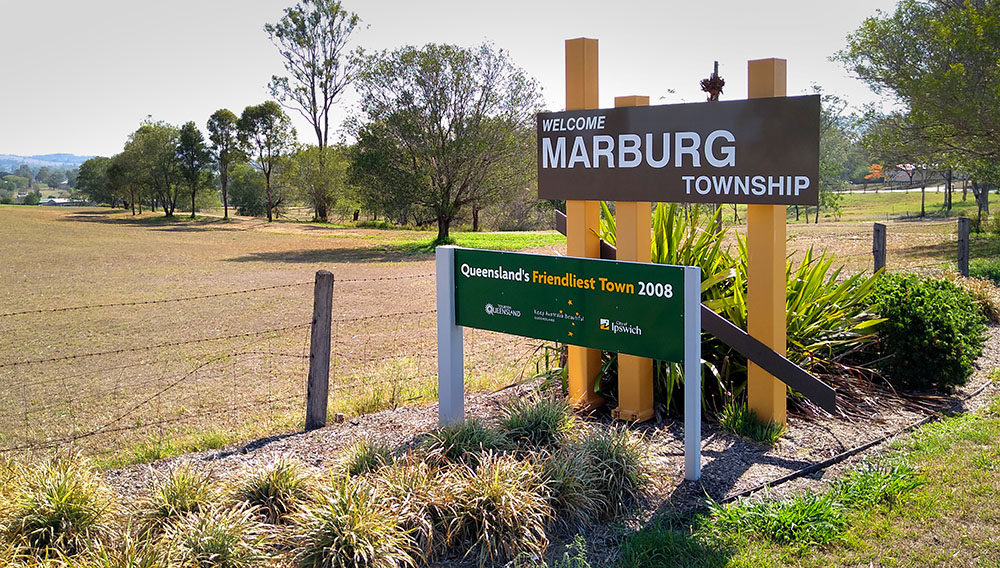Marburg is the town with many names.
The town was named after its German counterpart in about 1878 as it somewhat resembled the German university town of Marburg in geographical features.
But that is starting the story in the middle.
The town was not called Marburg for the final time until after WWII ended.
List of known names for areas of Marburg
First Plain
Sally Owens’ Plains
Rosewood Scrub
Frederick
Marburg
Townshend
Marburg (again)
Early photo of Marburg taken sometime before 1912. Image: Picture Ipswich
In the beginning, Marburg was once covered by the scrub and the valley was known firstly as First Plain.
The Brisbane Courier, 31 August 1907 states:
“In the squatting days, the valley where Marburg now stands was known as First Plain, and over the hill, where is now Minden, was called Second Plain.
Some early settlers to the area were Sam and Sarah Owens.
They ran the Tarampa sheep station around 1842.
Mr Owens and his wife, who was known as Sally, were shepherding sheep on the land so the grassy flats became known at that time as Sally Owens’ Plains.
Light Horse on parade in Marburg 1911. Image: Picture Ipswich
Marburg School 1910. Image: Picture Ipswich
The Rosewood Scrub was a huge tract of dense vine forest which stretched from Rosewood in the south to Fernvale in the north.
It was observed by the explorer Allan Cunningham who was unable to make his way through it and instead, skirted around the area.
The later explorer Ludwig Leichhardt also observed the scrub and probably was the first to use the term ‘Rosewood Scrub’.
After its population increased the name of the general area was known as Rosewood Scrub on account of the timber, which grew in its scrubs, so closely resembling rosewood in that it was very easy to split.
After the New Homestead or Free Settlers Act was passed in 1868, the first small settlers, mostly of German decent, began to make their appearance.
Clearing of the scrub began in the 1870s. The timber, sugar cane and dairy industries put Marburg on its feet.
The Brisbane Courier, 31 August 1907 states:
Then the scrub lands, which were regarded as useless, were thrown open and German settlers began to carve out homes for themselves.
It was always Germans who took up this class of country, and soon a sturdy little settlement was established. Mr. J. L. Frederick was one of the early comers, and the name of Frederick was selected for the locality.
At the time the German settlers were carting their produce to Walloon Railway Station, and in talking to the station-master they found difficulty in describing their addresses beyond ‘ober dar.’
The first German settlers had arrived by 1870 and by 1880, most of the area was settled.
Many of these families establishing dairy and pig farms as well as vegetable and grain crops.
Sugar cane and coal were also widely produced and mined in this area.
The school was opened 1879 and was originally named Frederick School.
The school was moved to its current location in 1922 as the Marburg Rural School and today is the Marburg State School.
Interestingly, it was J.L Frederick who put forward the name Marburg.
It was about 1879 that Marburg was named after a town in Hesse-Nassau province in Prussia (now called Germany)
J.L. Frederick’s store and Marburg butter factory in 1918. Image: Picture Ipswich
So back to the middle of the story.
As a result of the anti-German feeling in WWI, Marburg’s name was changed to Townshend in 1917.
Townshend was a British general at the time.
The name change was short lived and reverted back to Marburg in 1920.
Nearby Minden was originally called Back Plains and was changed in 1884 after a town in Germany.
Like Marburg it was renamed Frenchton during WWI but the name reverted to Minden in 1930.
Haigslea was originally called Kircheim which meant home of churches. It was renamed Haigslea after General Haig during WWI but this one stuck.
Today, Marburg has a population of about 870 people and is part of the City of Ipswich.
Marburg today
Marburg, 15 minutes west of Ipswich Central, is known for many things like the weekly Marburg dances, having one of the grandest mansions in Ipswich with Woodlands and it’s many heritage buildings.
Visitors to Marburg can enjoy exploring on foot from the main intersection.
From there you can see the iconic Marburg Hotel; the Community Centre, formerly the town’s bank; Rosewood Scrub Historical Museum with lots of early photos of the area; old Bielefeld’s Store, now an antique centre; the old Police Station, courthouse and lock-up; and the Anglican cemetery, the resting place of many of the area’s pioneers.
A sugar plantation and sugar mill were started nearby at Woodlands in the early 1880s.
South Sea Islanders worked there, and many local farmers also grew cane to supply the mill.
None of the Islanders working at Woodlands were brought to Marburg.
They were time-expired boys – that is, they had willingly stayed in Queensland after fulfilling their original contract.
These men worked in the fields and lived in huts on the western side of the property.
The Half-Way Cafe was opened in 1947 by Fred and Edna Linning, closing in 1969. Image: Picture Ipswich
From the 1920s to the 1970s, the main highway passed through Marburg.
Because it was half way from Brisbane to Toowoomba, many travellers stopped there and Day’s Café became known as “The Half-Way Café”.
Today the Day’s Café is part of the Antique Centre.
Across the road from the Antique Centre is the Marburg Hotel which was built in early 1881 as a single storey building with the second storey added in 1890.
In 1985, Marburg Hotel was used as a set for the movie ‘The Settlement’, starring Bill Kerr and John Jarratt. In the movie, the hotel was known as ‘Cedar Creek Hotel’.

